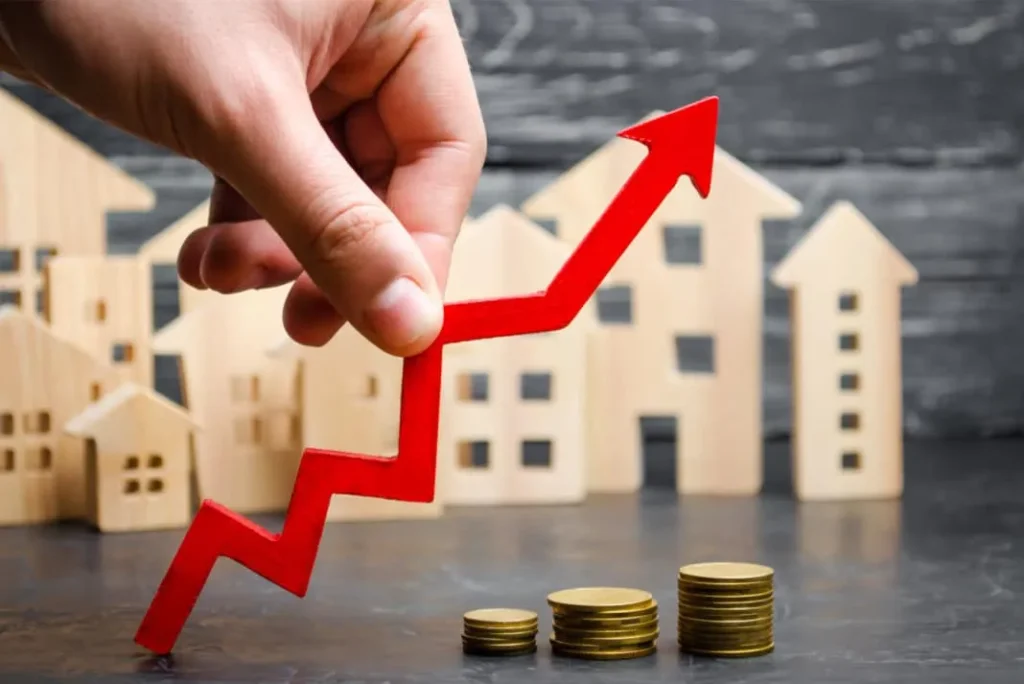What’s next in Real Estate News?
Stay ahead in the dynamic world of real estate with the latest insights! From smart homes and blockchain technology to sustainable living and the rise of virtual reality tours, discover the top 7 trends shaping the future of real estate in 2025. Get informed, get inspired, and stay competitive with cutting-edge real estate news!
Imagine a world where your home anticipates your needs, where blockchain simplifies property transactions, and where virtual reality lets you tour houses from your couch. These aren’t just far-off dreams – they’re the emerging realities of the real estate market. From the rise of smart homes to the impact of remote work, the next few years promise to bring exciting innovations and challenges. Are you prepared for what’s coming?
In this post, we’ll explore seven groundbreaking trends that are set to dominate the real estate scene in 2025. Whether you’re a homeowner, investor, or industry professional, understanding these shifts will be key to making informed decisions and capitalizing on new opportunities. Let’s dive into the future of real estate and discover how you can stay ahead of the game. 🚀
The Rise of Smart Homes
As we look ahead to 2025, smart homes are set to revolutionize the real estate industry. This technological advancement is not just a luxury but a growing necessity for homeowners and investors alike.
AI-powered property management
Artificial Intelligence is transforming how properties are managed. AI systems can:
- Predict maintenance needs
- Optimize energy usage
- Handle tenant inquiries 24/7
- Streamline rent collection processes
IoT integration in real estate
The Internet of Things (IoT) is creating interconnected living spaces. Key features include:
- Smart thermostats
- Connected appliances
- Automated lighting systems
- Voice-controlled home assistants
Energy-efficient home technologies
Sustainability is at the forefront of smart home design. Energy-efficient technologies offer:

| Technology | Benefit |
| Solar panels | Reduced electricity costs |
| Smart meters | Real-time energy monitoring |
| LED lighting | Lower energy consumption |
| Automated HVAC | Optimized climate control |
Enhanced security features
Smart homes are taking security to the next level with:
- Biometric access controls
- AI-powered surveillance cameras
- Smart locks with remote access
- Integrated alarm systems
As we move towards 2025, these smart home trends will significantly impact property values and buyer preferences. Next, we’ll explore how sustainability is shaping the future of housing.
Sustainable and Eco-Friendly Housing

As the real estate industry evolves, sustainable and eco-friendly housing is becoming a cornerstone of future development. This trend is driven by increasing environmental awareness and the need for energy-efficient living spaces.
Net-zero energy buildings
Net-zero energy buildings are at the forefront of sustainable housing. These structures produce as much energy as they consume over a year, typically through a combination of energy-efficient design and renewable energy systems.
- Solar panels for electricity generation
- High-performance insulation to reduce heating and cooling needs
- Energy-efficient appliances and lighting
- Smart home technology for optimized energy management
Biophilic design elements
Biophilic design incorporates natural elements into built environments, promoting well-being and connecting occupants with nature. This approach is gaining traction in sustainable housing design.
- Large windows for natural light and views
- Indoor plants and green walls
- Use of natural materials like wood and stone
- Water features and outdoor living spaces
Recycled and upcycled construction materials
The use of recycled and upcycled materials in construction is reducing waste and lowering the environmental impact of new housing developments.
| Material | Benefits |
| Recycled steel | Reduces mining and energy use |
| Reclaimed wood | Preserves forests and adds character |
| Recycled plastic | Reduces plastic waste in landfills |
| Recycled glass | Lowers energy consumption in production |
Green certifications and their impact on property value
Green certifications are becoming increasingly important in the real estate market, influencing property values and attracting environmentally conscious buyers.
- LEED (Leadership in Energy and Environmental Design)
- ENERGY STAR for homes
- BREEAM (Building Research Establishment Environmental Assessment Method)
- Living Building Challenge
These certifications not only validate a property’s sustainability features but also often lead to higher resale values and lower operating costs.
Virtual and Augmented Reality in Real Estate
As we delve into the exciting world of virtual and augmented reality in real estate, it’s clear that these technologies are revolutionizing the industry. Let’s explore how they’re transforming property tours, buying and selling processes, home staging, and architectural visualization.
Immersive Property Tours
Virtual reality (VR) is taking property tours to a whole new level. Potential buyers can now explore homes from the comfort of their own living rooms, saving time and resources. Here’s how VR is changing the game:
- 360-degree virtual walkthroughs
- Interactive floor plans
- Realistic sound effects for a truly immersive experience
Remote Buying and Selling Processes
The integration of VR and AR in real estate transactions is streamlining the buying and selling process:

| Traditional Process | VR/AR Enhanced Process |
| In-person viewings | Virtual property tours |
| Physical paperwork | Digital documentation |
| Face-to-face negotiations | Virtual meetings |
AR-Assisted Home Staging
Augmented reality is transforming home staging, allowing potential buyers to visualize properties in new ways:
- Virtual furniture placement
- Custom color schemes and decor options
- Real-time room measurements
VR for Architectural Visualization
Architects and developers are leveraging VR to bring their designs to life before breaking ground:
- 3D modeling of proposed buildings
- Virtual walkthroughs of unbuilt properties
- Interactive design modifications in real-time
As we look ahead to 2025, it’s clear that VR and AR will play an increasingly important role in shaping the future of real estate. Next, we’ll explore how blockchain technology is set to revolutionize property transactions.
Blockchain Technology in Property Transactions
As we explore the future of real estate, blockchain technology emerges as a game-changer in property transactions. This innovative approach is revolutionizing the industry by streamlining processes, enhancing security, and opening up new investment opportunities.
Smart contracts for faster closings
Smart contracts, powered by blockchain, are automating and expediting the closing process. These self-executing contracts eliminate the need for intermediaries, reducing closing times from weeks to mere hours. Here’s a comparison of traditional vs. blockchain-enabled closings:
| Aspect | Traditional Closing | Blockchain-Enabled Closing |
| Time | 30-45 days | 24-48 hours |
| Cost | 2-5% of property value | 0.5-1% of property value |
| Intermediaries | Multiple parties involved | Minimal to none |
Tokenization of real estate assets
Tokenization is transforming how we invest in real estate. By dividing properties into digital tokens, investors can now:
- Purchase fractional ownership in high-value properties
- Trade real estate assets more easily on secondary markets
- Enjoy increased liquidity in their real estate investments
Improved transparency in property records
Blockchain’s immutable ledger system is enhancing transparency and reducing fraud in property records. Benefits include:
- Tamper-proof historical records of ownership and transactions
- Real-time updates to property information
- Reduced title insurance costs due to decreased risk of errors
Fractional ownership opportunities
Blockchain is democratizing real estate investment through fractional ownership. This approach allows:
- Lower barriers to entry for small investors
- Diversification of real estate portfolios
- Increased accessibility to premium properties in desirable locations
As we move forward, the integration of blockchain in real estate transactions promises to make property dealings more efficient, transparent, and accessible to a broader range of investors.
Shifting Demographics and Housing Preferences
As we explore the evolving landscape of real estate, it’s crucial to understand how changing demographics are reshaping housing preferences. This shift is driving innovative approaches to home design and community planning.
Multigenerational Living Spaces
The demand for multigenerational homes is on the rise, reflecting changing family dynamics and economic factors. These versatile spaces accommodate multiple generations under one roof, offering both privacy and shared areas.
| Feature | Benefit |
| Separate entrances | Enhanced privacy |
| Flexible floor plans | Adaptable living arrangements |
| Multiple kitchens | Independence for each generation |
Micro-apartments and Tiny Homes
Urban centers are seeing a surge in micro-apartments and tiny homes, catering to young professionals and minimalists seeking affordable housing in prime locations.
- Efficient use of space
- Lower cost of living
- Reduced environmental impact
Co-living and Co-working Integration
The line between living and working spaces continues to blur, with integrated co-living and co-working communities gaining popularity.
Key Features:
- Shared amenities
- Flexible lease terms
- Built-in networking opportunities
Age-in-place Design Features
As the population ages, a growing focus is on homes allowing seniors to maintain independence and comfort.
- Wide doorways for wheelchair access
- Non-slip flooring
- Smart home technology for health monitoring
These trends reflect a dynamic real estate market adapting to diverse needs and preferences. Next, we’ll examine how climate change is influencing property development and investment strategies.
Climate Change Adaptation in Real Estate
As the effects of climate change become more pronounced, the real estate industry is adapting to meet new challenges. This section explores how property developers, homeowners, and investors respond to environmental risks.
Resilient Building Materials and Techniques
Climate-resilient construction is becoming increasingly important. Developers are turning to:
- Impact-resistant windows
- Water-resistant flooring
- Reinforced roofing materials
These materials not only protect against extreme weather but also increase property value and reduce maintenance costs.
Flood-Resistant Property Designs
With rising sea levels and increased flood risks, architects are reimagining residential and commercial designs:
- Elevated structures
- Permeable pavements
- Innovative drainage systems

| Design Feature | Benefit |
| Elevated foundations | Protects against flooding |
| Waterproof basements | Prevents water damage |
| Sump pumps | Removes excess water |
Wildfire Mitigation Strategies
In fire-prone areas, property owners are implementing preventive measures:
- Creating defensible spaces around buildings
- Using fire-resistant exterior materials
- Installing ember-resistant vents and eaves
These strategies protect properties and contribute to community-wide fire safety efforts.
Insurance Implications for High-Risk Areas
The insurance landscape is evolving in response to climate risks:
- Higher premiums in vulnerable locations
- New insurance products tailored to specific climate threats
- Incentives for implementing resilience measures
As we move forward, the real estate industry’s ability to adapt to climate change will be crucial in shaping sustainable and resilient communities.
The Impact of Remote Work on Real Estate
As we explore the future of real estate, it’s clear that remote work has become a game-changer, reshaping both residential and commercial landscapes. Let’s delve into how this shift is transforming the industry.
Rise of Satellite Cities and Exurbs
The flexibility of remote work has led to a surge in the popularity of satellite cities and exurbs. These areas offer:
- More affordable housing options
- Larger living spaces
- Access to nature and outdoor activities
- Lower cost of living
| Location Type | Housing Costs | Space | Lifestyle |
| Urban Centers | High | Limited | Fast-paced |
| Satellite Cities | Moderate | Spacious | Balanced |
| Exurbs | Low | Expansive | Relaxed |
Home Office Design Trends
With remote work becoming the norm, home office design has evolved significantly:
- Multifunctional spaces
- Ergonomic furniture
- High-speed internet infrastructure
- Soundproofing solutions
- Natural lighting emphasis
Flexible Zoning for Live-Work Spaces
Municipalities are adapting zoning laws to accommodate the blending of residential and commercial spaces. This shift allows for:
- Home-based businesses
- Mixed-use developments
- Coworking spaces within residential areas
Community Amenities for Remote Workers
Developers are now focusing on creating communities that cater to remote workers:
- Shared workspaces in residential complexes
- High-speed community-wide Wi-Fi
- Outdoor meeting areas and walking trails
- Social spaces for networking and collaboration
Shifts in Commercial Real Estate Demand
The rise of remote work has significantly impacted commercial real estate:
- Decreased demand for traditional office spaces
- Increased interest in flexible and hybrid workplace solutions
- Repurposing of vacant office buildings for residential or mixed-use purposes
As we look ahead to 2025, it’s clear that the real estate industry must continue to adapt to these evolving work trends, creating innovative solutions that bridge the gap between our professional and personal lives.
Conclusion
The real estate landscape is set to undergo significant transformations by 2025, driven by technological advancements, changing demographics, and environmental concerns. Smart homes, sustainable housing, and virtual reality experiences are reshaping how we interact with properties. Blockchain technology is revolutionizing property transactions, while shifting demographics and the rise of remote work are influencing housing preferences and market dynamics. Additionally, the real estate industry is adapting to climate change challenges, emphasizing resilience and sustainability in property development.
As we move towards 2025, staying informed about these trends will be crucial for real estate professionals, investors, and homeowners alike. Embracing these changes and adapting strategies accordingly will be key to success in the evolving real estate landscape. Whether you’re buying, selling, or investing in property, keeping these seven trends in mind will help you make informed decisions and stay ahead in the dynamic world of real estate.
FAQs
What are the top real estate trends expected in 2025?
In 2025, key trends include the rise of smart homes, eco-friendly housing, increased adoption of technology like virtual reality and blockchain, and a focus on properties suited for remote work lifestyles.
How is smart home technology impacting real estate?
Smart home technology is boosting property value and buyer interest by offering convenience, security, and energy efficiency, making homes more appealing to tech-savvy buyers.
What role does blockchain play in real estate transactions?
Blockchain simplifies property transactions by ensuring secure, transparent, and efficient processes, reducing fraud, and enabling smart contracts for quicker deals.
Are sustainable and eco-friendly homes gaining value in the market?
Yes, sustainable homes are increasingly valued for their long-term cost savings, environmental benefits, and appeal to eco-conscious buyers.
How is remote work shaping housing preferences?
Remote work is driving demand for homes with office spaces, suburban properties, and locations offering better quality of life over proximity to urban centers.
What are the benefits of virtual reality for real estate buyers and sellers?
Virtual reality allows buyers to tour properties remotely, saving time and effort, while helping sellers showcase homes to a broader audience more effectively.
How can real estate professionals adapt to climate change challenges?
Professionals can adapt by promoting resilient building designs, incorporating sustainable practices, and understanding market shifts toward environmentally-friendly housing.

